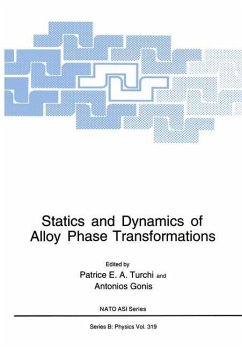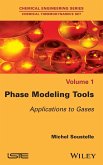Michel Soustelle
Phase Transformations
Michel Soustelle
Phase Transformations
- Gebundenes Buch
- Merkliste
- Auf die Merkliste
- Bewerten Bewerten
- Teilen
- Produkt teilen
- Produkterinnerung
- Produkterinnerung
This book is part of a set of books which offers advanced students successive characterization tool phases, the study of all types of phase (liquid, gas and solid, pure or multi-component), process engineering, chemical and electrochemical equilibria, and the properties of surfaces and phases of small sizes. Macroscopic and microscopic models are in turn covered with a constant correlation between the two scales. Particular attention has been given to the rigor of mathematical developments. This fifth volume is devoted to the study of transformations and equilibria between phases. First- and…mehr
Andere Kunden interessierten sich auch für
![Statics and Dynamics of Alloy Phase Transformations Statics and Dynamics of Alloy Phase Transformations]() Statics and Dynamics of Alloy Phase Transformations54,99 €
Statics and Dynamics of Alloy Phase Transformations54,99 €![Phase Modeling Tools Phase Modeling Tools]() Michel SoustellePhase Modeling Tools189,99 €
Michel SoustellePhase Modeling Tools189,99 €![Arylboronic Acids: An efficient synthon in organic transformations Arylboronic Acids: An efficient synthon in organic transformations]() Ankur GogoiArylboronic Acids: An efficient synthon in organic transformations44,99 €
Ankur GogoiArylboronic Acids: An efficient synthon in organic transformations44,99 €![Transformations promoted by the hypervalent iodine reagents Transformations promoted by the hypervalent iodine reagents]() Zhiyu JiaTransformations promoted by the hypervalent iodine reagents51,99 €
Zhiyu JiaTransformations promoted by the hypervalent iodine reagents51,99 €![Solid State Transformations Solid State Transformations]() N. N. SirotaSolid State Transformations42,99 €
N. N. SirotaSolid State Transformations42,99 €![Magic of natural material in organic transformations Magic of natural material in organic transformations]() Megha PatilMagic of natural material in organic transformations68,99 €
Megha PatilMagic of natural material in organic transformations68,99 €![Biogeochemical Transformations in the Baltic Sea Biogeochemical Transformations in the Baltic Sea]() Bernd SchneiderBiogeochemical Transformations in the Baltic Sea70,99 €
Bernd SchneiderBiogeochemical Transformations in the Baltic Sea70,99 €-
-
-
This book is part of a set of books which offers advanced students successive characterization tool phases, the study of all types of phase (liquid, gas and solid, pure or multi-component), process engineering, chemical and electrochemical equilibria, and the properties of surfaces and phases of small sizes. Macroscopic and microscopic models are in turn covered with a constant correlation between the two scales. Particular attention has been given to the rigor of mathematical developments. This fifth volume is devoted to the study of transformations and equilibria between phases. First- and second-order pure phase transformations are presented in detail, just as with the macroscopic and microscopic approaches of phase equilibria. In the presentation of binary systems, the thermodynamics of azeotropy and demixing are discussed in detail and applied to strictly-regular solutions. Eutectic and peritectic points are examined, as well as the reactions that go with them. The study of ternary systems then introduces the concepts of ternary azeotropes and eutectics. For each type of solid-liquid system, the interventions of definite compounds with or without congruent melting are taken into account. The particular properties of the different notable points of a diagram are also demonstrated.
Hinweis: Dieser Artikel kann nur an eine deutsche Lieferadresse ausgeliefert werden.
Hinweis: Dieser Artikel kann nur an eine deutsche Lieferadresse ausgeliefert werden.
Produktdetails
- Produktdetails
- Verlag: Wiley
- Seitenzahl: 250
- Erscheinungstermin: 7. Juni 2016
- Englisch
- Abmessung: 240mm x 161mm x 18mm
- Gewicht: 545g
- ISBN-13: 9781848218680
- ISBN-10: 1848218680
- Artikelnr.: 43356147
- Herstellerkennzeichnung
- Libri GmbH
- Europaallee 1
- 36244 Bad Hersfeld
- gpsr@libri.de
- Verlag: Wiley
- Seitenzahl: 250
- Erscheinungstermin: 7. Juni 2016
- Englisch
- Abmessung: 240mm x 161mm x 18mm
- Gewicht: 545g
- ISBN-13: 9781848218680
- ISBN-10: 1848218680
- Artikelnr.: 43356147
- Herstellerkennzeichnung
- Libri GmbH
- Europaallee 1
- 36244 Bad Hersfeld
- gpsr@libri.de
Michel SOUSTELLE is a chemical engineer and Emeritus Professor at Ecole des Mines de Saint-Etienne in France. He taught chemical kinetics from postgraduate to Master degree level while also carrying out research in this topic.
Preface xi
Notations and Symbols xv
Chapter 1. Phase Transformations of Pure Substances 1
1.1. Standard state: standard conditions of a transformation 1
1.2. Classification and general properties of phase transformations 2
1.2.1. First-order transformations and the Clapeyron relation 4
1.2.2. Second-order transformations 7
1.3. Liquid-vapor transformations and equilibrium states 16
1.3.1. Method of two equations of state, using the Clapeyron equation 16
1.3.2. Gibbs energy and fugacity method 18
1.3.3. Unique equation of state method 19
1.3.4. The region of the critical point and spinodal decomposition 21
1.3.5. Microscopic modeling 22
1.3.6. Liquid-vapor equilibrium in the presence of an inert gas 26
1.4. Solid-vapor transformations and equilibriums 28
1.4.1. Macroscopic treatment 28
1.4.2. Microscopic treatment 29
1.5. Transformations and solid-liquid equilibria 30
1.5.1. Macroscopic treatment 31
1.5.2. Microscopic treatment 31
1.6. Diagram for the pure substance and properties of the triple point 32
1.7. Allotropic and polymorphic varieties of a solid 35
1.7.1. Enantiotropy 36
1.7.2. Monotropy 39
1.7.3. Transition from enantiotropy to monotropy and vice versa 39
1.8. Mesomorphic states 40
Chapter 2. Properties of Equilibria Between Binary Phases 43
2.1. Classification of equilibria between the phases of binary systems 43
2.2. General properties of two-phase binary systems 45
2.2.1. Equilibrium conditions for two-phase binary systems 45
2.2.2. Conditions of evolution of a two-phase binary system 46
2.3. Graphical representation of two-phase binary systems 47
2.3.1. Gibbs energy graphs 47
2.3.2. Phase diagram in the mono- and bi-phase zones 53
2.3.3. Isobaric cooling curves 63
2.4. Isobaric representation of three-phase binary systems 66
2.4.1. Gibbs energy curve 66
2.4.2. Isobaric phase diagram in tri-phase regions 68
2.4.3. Isobaric cooling curves with tri-phase zones 70
2.5. Isothermal phase diagrams 72
2.6. Composition/composition curves 73
2.7. Activity of the components and consequences of Raoult's and Henry's
laws 73
Chapter 3. Equilibria Between Binary Condensed Phases 75
3.1. Equilibria between phases of the same nature: liquid-liquid or
solid-solid 76
3.1.1. Thermodynamics of demixing 76
3.1.2. Demixing in the case of low reciprocal solubilities 79
3.1.3. Demixing of strictly-regular solutions 81
3.2. Liquid-solid systems 84
3.2.1. Thermodynamics of the equilibria between a liquid phase and a solid
phase 86
3.2.2. Isobaric phase diagrams of equilibria between a solid and a liquid
90
3.2.3. Solidus and liquidus in the vicinity of the pure substance 97
3.3. Equilibria between two solids with two polymorphic varieties of the
solid 100
3.4. Applications of solid-liquid equilibria 102
3.4.1. Solubility of a solid in a liquid: Schröder-Le Châtelier law 102
3.4.2. Determination of molar mass by cryometry 104
3.5. Membrane equilibria - osmotic pressure 106
3.5.1. Thermodynamics of osmotic pressure 107
3.5.2. Osmotic pressure of infinitely-dilute solutions: the Van 't the Hoff
law 109
3.5.3. Application of osmotic pressure to the determination of the molar
mass of polymers 110
3.5.4. Osmotic pressure of strictly-regular solutions 111
3.5.5. Osmotic pressure and the osmotic coefficient 112
Chapter 4. Equilibria Between Binary Fluid Phases 113
4.1. Thermodynamics of liquid-vapor equilibrium in a binary system 113
4.2. Liquid-vapor equilibrium in perfect solutions far from the critical
conditions 117
4.2.1. Partial pressures and total pressure of a perfect solution 118
4.2.2. Isothermal diagram of a perfect solution 119
4.2.3. Isobaric diagram of a perfect solution 120
4.2.4. Phase composition curve 121
4.3. Liquid-gas equilibria in ideal dilute solutions 122
4.4. Diagrams of the liquid-vapor equilibria in real solutions 125
4.4.1. Total miscibility in the liquid phase 125
4.4.2. Partial miscibility in the liquid phase, heteroazeotropes 128
4.5. Thermodynamics of liquid-vapor azeotropy 129
4.5.1. Relation between the pressure of the azeotrope and the activity
coefficients of the liquid phase at the azeotropic composition 129
4.5.2. Relation between the activity coefficient and the temperature of the
azeotrope 130
4.6. Liquid-vapor equilibria and models of solutions 132
4.6.1. Liquid-vapor equilibria in strictly-regular solutions 132
4.6.2. Liquid-vapor equilibrium in associated solutions 137
4.7. Liquid-vapor equilibria in the critical region 140
4.8. Applications of liquid-vapor equilibria 143
4.8.1. Solubility of a gas in a liquid 143
4.8.2. Determination of molar masses by tonometry 145
4.8.3. Determination of molar masses by ebulliometry 146
4.8.4. Continuous rectification or fractional distillation 149
Chapter 5. Equilibria Between Ternary Fluid Phases 163
5.1. Representation of the composition of ternary systems 163
5.1.1. Symmetrical representation of the Gibbs triangle 163
5.1.2. Dissymmetrical representation of the right triangle 168
5.2. Representation of phase equilibria 169
5.2.1. Isothermal projections 169
5.2.2. Conjugate points and conodes 170
5.2.3. Isopleth sections 171
5.3. Equilibria in liquid phases with miscibility gaps 171
5.3.1. Representation of the miscibility gap 171
5.3.2. Sharing in liquid-liquid systems 173
5.3.3. Application of sharing between two liquids to solvent extraction
177
5.4. Liquid-vapor systems 182
5.4.1. Isothermal and isopleth sections (boiling and dew) 182
5.4.2. Distillation trajectories 184
5.4.3. Systems with two distillation fields 186
5.4.4. Systems with three distillation fields 187
5.5. Examples of applications of ternary diagrams between fluid phases 187
5.5.1. Treatment of argentiferous lead 187
5.5.2. Purity of oil products: aniline point 188
5.5.3. Obtaining concentrated ethyl alcohol 189
Chapter 6. Equilibria Between Condensed Ternary Fluid Phases 191
6.1. Solidification of a ternary system with total miscibility in the
liquid state and in the solid state 192
6.2. Solidification of a ternary system with no miscibility and with a
ternary eutectic 192
6.2.1. Invariant transformations of a liquid-solid ternary system 193
6.2.2. Representations of the ternary system with no miscibility in the
solid state 194
6.2.3. Lowering of the melting point of a binary system by the addition of
a component 199
6.2.4. Slope at the ternary eutectic 202
6.3. Ternary systems with partial miscibilities in the solid state and
ternary eutectic 204
6.4. Solidification of ternary systems with definite compounds 208
6.4.1. Ternary system with a binary definite compound binary with congruent
melting 208
6.4.2. Generalization to the case of a ternary compound and of multiple
definite compounds 211
6.4.3. Definite compound with incongruent melting: quasi-peritectic
transformation 213
6.5. A peritectic transformation in one binary system and total miscibility
in the other two 215
6.6. The ternary peritectic transformation 217
Bibliography 219
Index 221
Notations and Symbols xv
Chapter 1. Phase Transformations of Pure Substances 1
1.1. Standard state: standard conditions of a transformation 1
1.2. Classification and general properties of phase transformations 2
1.2.1. First-order transformations and the Clapeyron relation 4
1.2.2. Second-order transformations 7
1.3. Liquid-vapor transformations and equilibrium states 16
1.3.1. Method of two equations of state, using the Clapeyron equation 16
1.3.2. Gibbs energy and fugacity method 18
1.3.3. Unique equation of state method 19
1.3.4. The region of the critical point and spinodal decomposition 21
1.3.5. Microscopic modeling 22
1.3.6. Liquid-vapor equilibrium in the presence of an inert gas 26
1.4. Solid-vapor transformations and equilibriums 28
1.4.1. Macroscopic treatment 28
1.4.2. Microscopic treatment 29
1.5. Transformations and solid-liquid equilibria 30
1.5.1. Macroscopic treatment 31
1.5.2. Microscopic treatment 31
1.6. Diagram for the pure substance and properties of the triple point 32
1.7. Allotropic and polymorphic varieties of a solid 35
1.7.1. Enantiotropy 36
1.7.2. Monotropy 39
1.7.3. Transition from enantiotropy to monotropy and vice versa 39
1.8. Mesomorphic states 40
Chapter 2. Properties of Equilibria Between Binary Phases 43
2.1. Classification of equilibria between the phases of binary systems 43
2.2. General properties of two-phase binary systems 45
2.2.1. Equilibrium conditions for two-phase binary systems 45
2.2.2. Conditions of evolution of a two-phase binary system 46
2.3. Graphical representation of two-phase binary systems 47
2.3.1. Gibbs energy graphs 47
2.3.2. Phase diagram in the mono- and bi-phase zones 53
2.3.3. Isobaric cooling curves 63
2.4. Isobaric representation of three-phase binary systems 66
2.4.1. Gibbs energy curve 66
2.4.2. Isobaric phase diagram in tri-phase regions 68
2.4.3. Isobaric cooling curves with tri-phase zones 70
2.5. Isothermal phase diagrams 72
2.6. Composition/composition curves 73
2.7. Activity of the components and consequences of Raoult's and Henry's
laws 73
Chapter 3. Equilibria Between Binary Condensed Phases 75
3.1. Equilibria between phases of the same nature: liquid-liquid or
solid-solid 76
3.1.1. Thermodynamics of demixing 76
3.1.2. Demixing in the case of low reciprocal solubilities 79
3.1.3. Demixing of strictly-regular solutions 81
3.2. Liquid-solid systems 84
3.2.1. Thermodynamics of the equilibria between a liquid phase and a solid
phase 86
3.2.2. Isobaric phase diagrams of equilibria between a solid and a liquid
90
3.2.3. Solidus and liquidus in the vicinity of the pure substance 97
3.3. Equilibria between two solids with two polymorphic varieties of the
solid 100
3.4. Applications of solid-liquid equilibria 102
3.4.1. Solubility of a solid in a liquid: Schröder-Le Châtelier law 102
3.4.2. Determination of molar mass by cryometry 104
3.5. Membrane equilibria - osmotic pressure 106
3.5.1. Thermodynamics of osmotic pressure 107
3.5.2. Osmotic pressure of infinitely-dilute solutions: the Van 't the Hoff
law 109
3.5.3. Application of osmotic pressure to the determination of the molar
mass of polymers 110
3.5.4. Osmotic pressure of strictly-regular solutions 111
3.5.5. Osmotic pressure and the osmotic coefficient 112
Chapter 4. Equilibria Between Binary Fluid Phases 113
4.1. Thermodynamics of liquid-vapor equilibrium in a binary system 113
4.2. Liquid-vapor equilibrium in perfect solutions far from the critical
conditions 117
4.2.1. Partial pressures and total pressure of a perfect solution 118
4.2.2. Isothermal diagram of a perfect solution 119
4.2.3. Isobaric diagram of a perfect solution 120
4.2.4. Phase composition curve 121
4.3. Liquid-gas equilibria in ideal dilute solutions 122
4.4. Diagrams of the liquid-vapor equilibria in real solutions 125
4.4.1. Total miscibility in the liquid phase 125
4.4.2. Partial miscibility in the liquid phase, heteroazeotropes 128
4.5. Thermodynamics of liquid-vapor azeotropy 129
4.5.1. Relation between the pressure of the azeotrope and the activity
coefficients of the liquid phase at the azeotropic composition 129
4.5.2. Relation between the activity coefficient and the temperature of the
azeotrope 130
4.6. Liquid-vapor equilibria and models of solutions 132
4.6.1. Liquid-vapor equilibria in strictly-regular solutions 132
4.6.2. Liquid-vapor equilibrium in associated solutions 137
4.7. Liquid-vapor equilibria in the critical region 140
4.8. Applications of liquid-vapor equilibria 143
4.8.1. Solubility of a gas in a liquid 143
4.8.2. Determination of molar masses by tonometry 145
4.8.3. Determination of molar masses by ebulliometry 146
4.8.4. Continuous rectification or fractional distillation 149
Chapter 5. Equilibria Between Ternary Fluid Phases 163
5.1. Representation of the composition of ternary systems 163
5.1.1. Symmetrical representation of the Gibbs triangle 163
5.1.2. Dissymmetrical representation of the right triangle 168
5.2. Representation of phase equilibria 169
5.2.1. Isothermal projections 169
5.2.2. Conjugate points and conodes 170
5.2.3. Isopleth sections 171
5.3. Equilibria in liquid phases with miscibility gaps 171
5.3.1. Representation of the miscibility gap 171
5.3.2. Sharing in liquid-liquid systems 173
5.3.3. Application of sharing between two liquids to solvent extraction
177
5.4. Liquid-vapor systems 182
5.4.1. Isothermal and isopleth sections (boiling and dew) 182
5.4.2. Distillation trajectories 184
5.4.3. Systems with two distillation fields 186
5.4.4. Systems with three distillation fields 187
5.5. Examples of applications of ternary diagrams between fluid phases 187
5.5.1. Treatment of argentiferous lead 187
5.5.2. Purity of oil products: aniline point 188
5.5.3. Obtaining concentrated ethyl alcohol 189
Chapter 6. Equilibria Between Condensed Ternary Fluid Phases 191
6.1. Solidification of a ternary system with total miscibility in the
liquid state and in the solid state 192
6.2. Solidification of a ternary system with no miscibility and with a
ternary eutectic 192
6.2.1. Invariant transformations of a liquid-solid ternary system 193
6.2.2. Representations of the ternary system with no miscibility in the
solid state 194
6.2.3. Lowering of the melting point of a binary system by the addition of
a component 199
6.2.4. Slope at the ternary eutectic 202
6.3. Ternary systems with partial miscibilities in the solid state and
ternary eutectic 204
6.4. Solidification of ternary systems with definite compounds 208
6.4.1. Ternary system with a binary definite compound binary with congruent
melting 208
6.4.2. Generalization to the case of a ternary compound and of multiple
definite compounds 211
6.4.3. Definite compound with incongruent melting: quasi-peritectic
transformation 213
6.5. A peritectic transformation in one binary system and total miscibility
in the other two 215
6.6. The ternary peritectic transformation 217
Bibliography 219
Index 221
Preface xi
Notations and Symbols xv
Chapter 1. Phase Transformations of Pure Substances 1
1.1. Standard state: standard conditions of a transformation 1
1.2. Classification and general properties of phase transformations 2
1.2.1. First-order transformations and the Clapeyron relation 4
1.2.2. Second-order transformations 7
1.3. Liquid-vapor transformations and equilibrium states 16
1.3.1. Method of two equations of state, using the Clapeyron equation 16
1.3.2. Gibbs energy and fugacity method 18
1.3.3. Unique equation of state method 19
1.3.4. The region of the critical point and spinodal decomposition 21
1.3.5. Microscopic modeling 22
1.3.6. Liquid-vapor equilibrium in the presence of an inert gas 26
1.4. Solid-vapor transformations and equilibriums 28
1.4.1. Macroscopic treatment 28
1.4.2. Microscopic treatment 29
1.5. Transformations and solid-liquid equilibria 30
1.5.1. Macroscopic treatment 31
1.5.2. Microscopic treatment 31
1.6. Diagram for the pure substance and properties of the triple point 32
1.7. Allotropic and polymorphic varieties of a solid 35
1.7.1. Enantiotropy 36
1.7.2. Monotropy 39
1.7.3. Transition from enantiotropy to monotropy and vice versa 39
1.8. Mesomorphic states 40
Chapter 2. Properties of Equilibria Between Binary Phases 43
2.1. Classification of equilibria between the phases of binary systems 43
2.2. General properties of two-phase binary systems 45
2.2.1. Equilibrium conditions for two-phase binary systems 45
2.2.2. Conditions of evolution of a two-phase binary system 46
2.3. Graphical representation of two-phase binary systems 47
2.3.1. Gibbs energy graphs 47
2.3.2. Phase diagram in the mono- and bi-phase zones 53
2.3.3. Isobaric cooling curves 63
2.4. Isobaric representation of three-phase binary systems 66
2.4.1. Gibbs energy curve 66
2.4.2. Isobaric phase diagram in tri-phase regions 68
2.4.3. Isobaric cooling curves with tri-phase zones 70
2.5. Isothermal phase diagrams 72
2.6. Composition/composition curves 73
2.7. Activity of the components and consequences of Raoult's and Henry's
laws 73
Chapter 3. Equilibria Between Binary Condensed Phases 75
3.1. Equilibria between phases of the same nature: liquid-liquid or
solid-solid 76
3.1.1. Thermodynamics of demixing 76
3.1.2. Demixing in the case of low reciprocal solubilities 79
3.1.3. Demixing of strictly-regular solutions 81
3.2. Liquid-solid systems 84
3.2.1. Thermodynamics of the equilibria between a liquid phase and a solid
phase 86
3.2.2. Isobaric phase diagrams of equilibria between a solid and a liquid
90
3.2.3. Solidus and liquidus in the vicinity of the pure substance 97
3.3. Equilibria between two solids with two polymorphic varieties of the
solid 100
3.4. Applications of solid-liquid equilibria 102
3.4.1. Solubility of a solid in a liquid: Schröder-Le Châtelier law 102
3.4.2. Determination of molar mass by cryometry 104
3.5. Membrane equilibria - osmotic pressure 106
3.5.1. Thermodynamics of osmotic pressure 107
3.5.2. Osmotic pressure of infinitely-dilute solutions: the Van 't the Hoff
law 109
3.5.3. Application of osmotic pressure to the determination of the molar
mass of polymers 110
3.5.4. Osmotic pressure of strictly-regular solutions 111
3.5.5. Osmotic pressure and the osmotic coefficient 112
Chapter 4. Equilibria Between Binary Fluid Phases 113
4.1. Thermodynamics of liquid-vapor equilibrium in a binary system 113
4.2. Liquid-vapor equilibrium in perfect solutions far from the critical
conditions 117
4.2.1. Partial pressures and total pressure of a perfect solution 118
4.2.2. Isothermal diagram of a perfect solution 119
4.2.3. Isobaric diagram of a perfect solution 120
4.2.4. Phase composition curve 121
4.3. Liquid-gas equilibria in ideal dilute solutions 122
4.4. Diagrams of the liquid-vapor equilibria in real solutions 125
4.4.1. Total miscibility in the liquid phase 125
4.4.2. Partial miscibility in the liquid phase, heteroazeotropes 128
4.5. Thermodynamics of liquid-vapor azeotropy 129
4.5.1. Relation between the pressure of the azeotrope and the activity
coefficients of the liquid phase at the azeotropic composition 129
4.5.2. Relation between the activity coefficient and the temperature of the
azeotrope 130
4.6. Liquid-vapor equilibria and models of solutions 132
4.6.1. Liquid-vapor equilibria in strictly-regular solutions 132
4.6.2. Liquid-vapor equilibrium in associated solutions 137
4.7. Liquid-vapor equilibria in the critical region 140
4.8. Applications of liquid-vapor equilibria 143
4.8.1. Solubility of a gas in a liquid 143
4.8.2. Determination of molar masses by tonometry 145
4.8.3. Determination of molar masses by ebulliometry 146
4.8.4. Continuous rectification or fractional distillation 149
Chapter 5. Equilibria Between Ternary Fluid Phases 163
5.1. Representation of the composition of ternary systems 163
5.1.1. Symmetrical representation of the Gibbs triangle 163
5.1.2. Dissymmetrical representation of the right triangle 168
5.2. Representation of phase equilibria 169
5.2.1. Isothermal projections 169
5.2.2. Conjugate points and conodes 170
5.2.3. Isopleth sections 171
5.3. Equilibria in liquid phases with miscibility gaps 171
5.3.1. Representation of the miscibility gap 171
5.3.2. Sharing in liquid-liquid systems 173
5.3.3. Application of sharing between two liquids to solvent extraction
177
5.4. Liquid-vapor systems 182
5.4.1. Isothermal and isopleth sections (boiling and dew) 182
5.4.2. Distillation trajectories 184
5.4.3. Systems with two distillation fields 186
5.4.4. Systems with three distillation fields 187
5.5. Examples of applications of ternary diagrams between fluid phases 187
5.5.1. Treatment of argentiferous lead 187
5.5.2. Purity of oil products: aniline point 188
5.5.3. Obtaining concentrated ethyl alcohol 189
Chapter 6. Equilibria Between Condensed Ternary Fluid Phases 191
6.1. Solidification of a ternary system with total miscibility in the
liquid state and in the solid state 192
6.2. Solidification of a ternary system with no miscibility and with a
ternary eutectic 192
6.2.1. Invariant transformations of a liquid-solid ternary system 193
6.2.2. Representations of the ternary system with no miscibility in the
solid state 194
6.2.3. Lowering of the melting point of a binary system by the addition of
a component 199
6.2.4. Slope at the ternary eutectic 202
6.3. Ternary systems with partial miscibilities in the solid state and
ternary eutectic 204
6.4. Solidification of ternary systems with definite compounds 208
6.4.1. Ternary system with a binary definite compound binary with congruent
melting 208
6.4.2. Generalization to the case of a ternary compound and of multiple
definite compounds 211
6.4.3. Definite compound with incongruent melting: quasi-peritectic
transformation 213
6.5. A peritectic transformation in one binary system and total miscibility
in the other two 215
6.6. The ternary peritectic transformation 217
Bibliography 219
Index 221
Notations and Symbols xv
Chapter 1. Phase Transformations of Pure Substances 1
1.1. Standard state: standard conditions of a transformation 1
1.2. Classification and general properties of phase transformations 2
1.2.1. First-order transformations and the Clapeyron relation 4
1.2.2. Second-order transformations 7
1.3. Liquid-vapor transformations and equilibrium states 16
1.3.1. Method of two equations of state, using the Clapeyron equation 16
1.3.2. Gibbs energy and fugacity method 18
1.3.3. Unique equation of state method 19
1.3.4. The region of the critical point and spinodal decomposition 21
1.3.5. Microscopic modeling 22
1.3.6. Liquid-vapor equilibrium in the presence of an inert gas 26
1.4. Solid-vapor transformations and equilibriums 28
1.4.1. Macroscopic treatment 28
1.4.2. Microscopic treatment 29
1.5. Transformations and solid-liquid equilibria 30
1.5.1. Macroscopic treatment 31
1.5.2. Microscopic treatment 31
1.6. Diagram for the pure substance and properties of the triple point 32
1.7. Allotropic and polymorphic varieties of a solid 35
1.7.1. Enantiotropy 36
1.7.2. Monotropy 39
1.7.3. Transition from enantiotropy to monotropy and vice versa 39
1.8. Mesomorphic states 40
Chapter 2. Properties of Equilibria Between Binary Phases 43
2.1. Classification of equilibria between the phases of binary systems 43
2.2. General properties of two-phase binary systems 45
2.2.1. Equilibrium conditions for two-phase binary systems 45
2.2.2. Conditions of evolution of a two-phase binary system 46
2.3. Graphical representation of two-phase binary systems 47
2.3.1. Gibbs energy graphs 47
2.3.2. Phase diagram in the mono- and bi-phase zones 53
2.3.3. Isobaric cooling curves 63
2.4. Isobaric representation of three-phase binary systems 66
2.4.1. Gibbs energy curve 66
2.4.2. Isobaric phase diagram in tri-phase regions 68
2.4.3. Isobaric cooling curves with tri-phase zones 70
2.5. Isothermal phase diagrams 72
2.6. Composition/composition curves 73
2.7. Activity of the components and consequences of Raoult's and Henry's
laws 73
Chapter 3. Equilibria Between Binary Condensed Phases 75
3.1. Equilibria between phases of the same nature: liquid-liquid or
solid-solid 76
3.1.1. Thermodynamics of demixing 76
3.1.2. Demixing in the case of low reciprocal solubilities 79
3.1.3. Demixing of strictly-regular solutions 81
3.2. Liquid-solid systems 84
3.2.1. Thermodynamics of the equilibria between a liquid phase and a solid
phase 86
3.2.2. Isobaric phase diagrams of equilibria between a solid and a liquid
90
3.2.3. Solidus and liquidus in the vicinity of the pure substance 97
3.3. Equilibria between two solids with two polymorphic varieties of the
solid 100
3.4. Applications of solid-liquid equilibria 102
3.4.1. Solubility of a solid in a liquid: Schröder-Le Châtelier law 102
3.4.2. Determination of molar mass by cryometry 104
3.5. Membrane equilibria - osmotic pressure 106
3.5.1. Thermodynamics of osmotic pressure 107
3.5.2. Osmotic pressure of infinitely-dilute solutions: the Van 't the Hoff
law 109
3.5.3. Application of osmotic pressure to the determination of the molar
mass of polymers 110
3.5.4. Osmotic pressure of strictly-regular solutions 111
3.5.5. Osmotic pressure and the osmotic coefficient 112
Chapter 4. Equilibria Between Binary Fluid Phases 113
4.1. Thermodynamics of liquid-vapor equilibrium in a binary system 113
4.2. Liquid-vapor equilibrium in perfect solutions far from the critical
conditions 117
4.2.1. Partial pressures and total pressure of a perfect solution 118
4.2.2. Isothermal diagram of a perfect solution 119
4.2.3. Isobaric diagram of a perfect solution 120
4.2.4. Phase composition curve 121
4.3. Liquid-gas equilibria in ideal dilute solutions 122
4.4. Diagrams of the liquid-vapor equilibria in real solutions 125
4.4.1. Total miscibility in the liquid phase 125
4.4.2. Partial miscibility in the liquid phase, heteroazeotropes 128
4.5. Thermodynamics of liquid-vapor azeotropy 129
4.5.1. Relation between the pressure of the azeotrope and the activity
coefficients of the liquid phase at the azeotropic composition 129
4.5.2. Relation between the activity coefficient and the temperature of the
azeotrope 130
4.6. Liquid-vapor equilibria and models of solutions 132
4.6.1. Liquid-vapor equilibria in strictly-regular solutions 132
4.6.2. Liquid-vapor equilibrium in associated solutions 137
4.7. Liquid-vapor equilibria in the critical region 140
4.8. Applications of liquid-vapor equilibria 143
4.8.1. Solubility of a gas in a liquid 143
4.8.2. Determination of molar masses by tonometry 145
4.8.3. Determination of molar masses by ebulliometry 146
4.8.4. Continuous rectification or fractional distillation 149
Chapter 5. Equilibria Between Ternary Fluid Phases 163
5.1. Representation of the composition of ternary systems 163
5.1.1. Symmetrical representation of the Gibbs triangle 163
5.1.2. Dissymmetrical representation of the right triangle 168
5.2. Representation of phase equilibria 169
5.2.1. Isothermal projections 169
5.2.2. Conjugate points and conodes 170
5.2.3. Isopleth sections 171
5.3. Equilibria in liquid phases with miscibility gaps 171
5.3.1. Representation of the miscibility gap 171
5.3.2. Sharing in liquid-liquid systems 173
5.3.3. Application of sharing between two liquids to solvent extraction
177
5.4. Liquid-vapor systems 182
5.4.1. Isothermal and isopleth sections (boiling and dew) 182
5.4.2. Distillation trajectories 184
5.4.3. Systems with two distillation fields 186
5.4.4. Systems with three distillation fields 187
5.5. Examples of applications of ternary diagrams between fluid phases 187
5.5.1. Treatment of argentiferous lead 187
5.5.2. Purity of oil products: aniline point 188
5.5.3. Obtaining concentrated ethyl alcohol 189
Chapter 6. Equilibria Between Condensed Ternary Fluid Phases 191
6.1. Solidification of a ternary system with total miscibility in the
liquid state and in the solid state 192
6.2. Solidification of a ternary system with no miscibility and with a
ternary eutectic 192
6.2.1. Invariant transformations of a liquid-solid ternary system 193
6.2.2. Representations of the ternary system with no miscibility in the
solid state 194
6.2.3. Lowering of the melting point of a binary system by the addition of
a component 199
6.2.4. Slope at the ternary eutectic 202
6.3. Ternary systems with partial miscibilities in the solid state and
ternary eutectic 204
6.4. Solidification of ternary systems with definite compounds 208
6.4.1. Ternary system with a binary definite compound binary with congruent
melting 208
6.4.2. Generalization to the case of a ternary compound and of multiple
definite compounds 211
6.4.3. Definite compound with incongruent melting: quasi-peritectic
transformation 213
6.5. A peritectic transformation in one binary system and total miscibility
in the other two 215
6.6. The ternary peritectic transformation 217
Bibliography 219
Index 221








